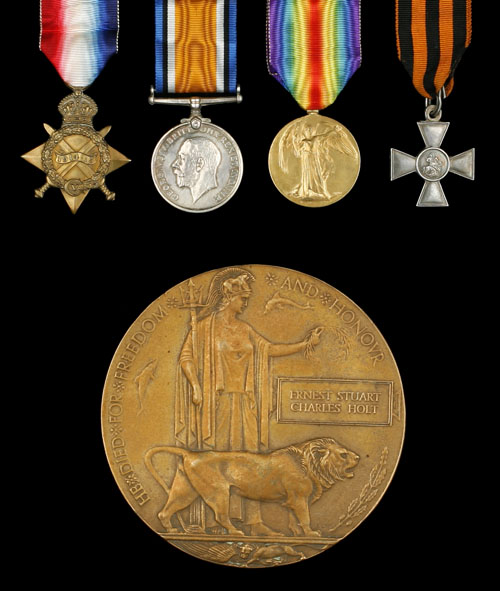
Auction: 9033 - Orders, Decorations, Campaign Medals & Militaria
Lot: 79
The Rare and Unusual Great War Russian Cross of St. George Group of Four to Ordinary Telegraphist E.S.C. Holt, Royal Navy, of H.M. Submarine E13, Who, Together With a Number of the Crew Were Killed When, After E13 Had Ran-Aground in Neutral Danish Waters, She Was Attacked by Two German Motor Torpedo Boats in One of the Most Infamous Naval Incidents of the Great War 1914-15 Star (J.26522, E.S.C. Holt, O. Tel., R.N.); British War and Victory Medals (J.26522 E.S.C. Holt. O. Tel. R.N.), in named card box of issue; Russia, Imperial, Cross of St. George, Fourth Class, silver, reverse officially numbered ´167441´, in the rare Russian named box of issue, nearly extremely fine, with the recipient´s Great War Bronze Memorial Plaque ´Ernest Stuart Charles Holt´; three photographs of the recipient´s funeral procession; and a number of newspaper cuttings (4) Estimate £ 1,400-1,800 J.26522 Ordinary Telegraphist Ernest Stuart Charles Holt, born 1897, the son of Mr. and Mrs. John Holt, of Forest Gate, East London; served with the Royal Navy during the Great War in H.M. Submarine E13; killed in action 19.8.1915, and is buried in Haslar Royal Naval Cemetery, Hampshire. H.M. Submarine E13 During the night of the 18th-19th August, 1915, H.M. Submarines E8 and E13 attempted to pass through the narrow waters of the Sound, between Denmark and Sweden, on passage to reinforce the British submarine forces already operating in the Baltic Sea. Danish and Swedish Naval vessels were patrolling the Sound, protecting the neutrality of these two countries during the Great War, and additionally the area was heavily mined. E13, commanded by Lieutenant-Commander G. Layton, made a course close to the coast but, due to an apparent compass failure, ran aground on the Danish island of Saltholm, inside Danish territorial waters. Then followed one of the most stirring deeds of heroism in British naval history. Refusing the offers of fisherman to bring them ashore in their boats, so as not to violate Danish neutrality, the crew resumed their posts on the deck of the listing vessel. Shortly after dawn the Danish ship Narhvalen approached the E13 and informed the submarine´s Commanding Officer that, in accordance with Danish neutrality and International law, the E13 was required to depart from Danish territorial waters within 24 hours, otherwise both the vessel and its crew would be interned. Additional Danish ships were ordered to the area, to monitor the situation, and to prevent any German attack in neutral waters. At 10:28 a.m. two German motor torpedo boats, G132 and G134, approached from the south at full speed. As soon as they were within firing range, G132, under the command of Lieutenant Graf von Montgelas, fired a torpedo at the E13. It missed, and exploded upon striking the sea floor. The enemy torpedo boat immediately thereafter employed its deck gun against the helpless British submarine. ´The crew of the E13 formed into a line on deck with crossed arms, facing the enemy´s gun, immovable and stationary, and looking death in the face without moving a muscle: "They were brave men, those English", said a fisherman who watched the scene. They were shot down, defenceless, by the German destroyers [sic]´ (Newspaper article with lot refers). Finally, the Danish ship Søulven intervened, launching a lifeboat to rescue any survivors, and steaming towards the G132 at full speed to protest against this violation of Danish neutrality. Following this intervention, the G132 and G134 called off their murderous attack and returned to base. 15 of the crew were killed, their bodies later recovered by the Royal Danish Navy; the surviving British submariners, 14 in total, including the Commanding Officer Lieutenant-Commander G. Layton, were rescued by the Danish lifeboat, and interned in Denmark for the rest of the War. The outrage evoked a wave of indignation throughout the neutral countries. The bodies of the fallen were brought to Hull, with all honour, under the Danish flag. Wreaths and flowers from every part of Denmark came with them, and Danish sailors formed a guard of honour at the funeral procession. Holt, together with six other of the victims, was buried with full Naval honours at Haslar Cemetery, with a wreath sent by Queen Alexandra carried on his coffin. For his gallantry Telegraphist Holt was awarded the Cross of St. George by the Russian Government, the E13 having been on its way to assist in the Baltic Sea: "The Chapter of the Russian Imperial and Royal Orders hereby testify that His Imperial Russian Majesty has been graciously pleased to confer on the 5th October, 1915, the Cross of St. George, 4th Class, No. 167441, on Ernest Stewart Charles Holt, ord. telegraphist, of the Submarine E13. Petrograd, October 24th, 1915" (Newspaper cuttings included with lot refer). The Commanding Officer of E13, Lieutenant-Commander G. Layton, managed to escape from his internment and return to England, and was later awarded the D.S.O. for his War-time services (London Gazette 17.4.1918). ´Commander Layton was in command of Submarine E13 when she grounded on the Danish Island of Saltholm on the 19th August, 1915, and was subsequently shelled by two German destroyers in the presence of Danish destroyers. Commander Layton was interned, but eventually escaped. His crew were interned on parole, but Commander Layton refused to promise not to escape, and accordingly was kept under close surveillance at the naval barracks at Copenhagen. Despite the utmost vigilance he quitted his bed one night, leaving in his place a dummy, and got through the pantry window. From Copenhagen he made his way to Bergen, and thence to Newcastle-upon-Tyne.´ (The Distinguished Service Order 1886-1923 refers). Later Admiral Sir Geoffrey Layton, G.B.E., K.C.B., K.C.M.G., D.S.O., he was Commanding Officer in South East Asia when the Japanese invaded Singapore in 1942.
Sold for
£11,500




